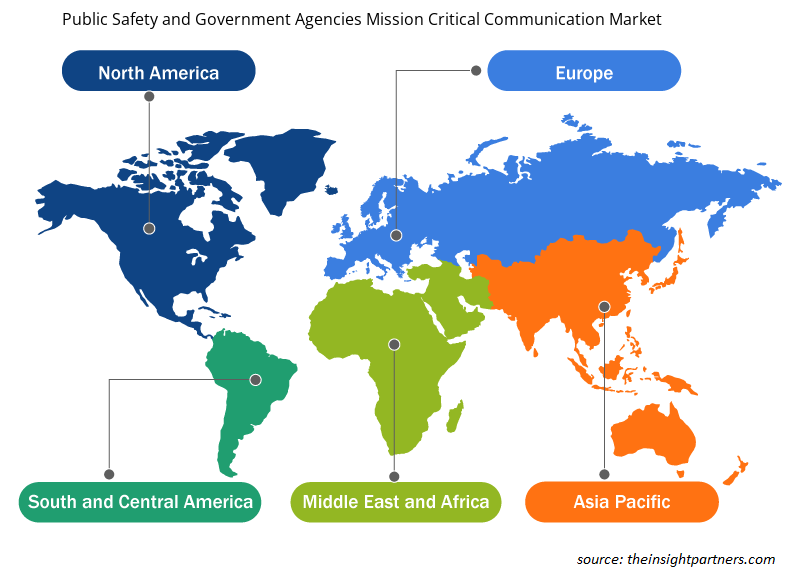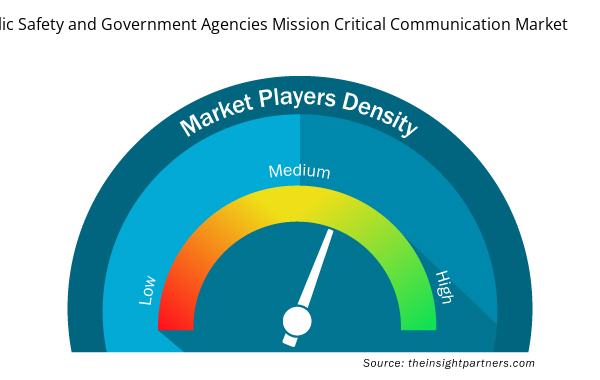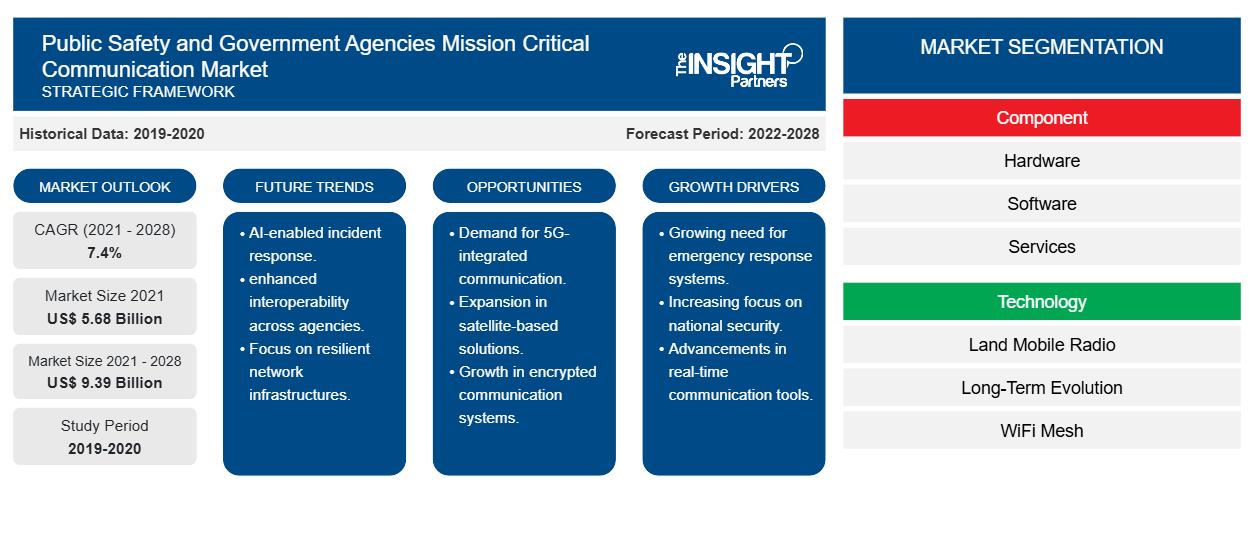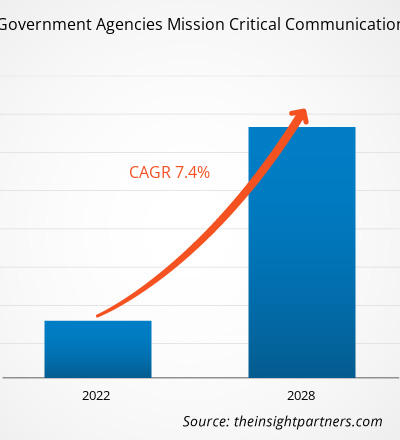Der Markt für unternehmenskritische Kommunikation für öffentliche Sicherheit und Regierungsbehörden wurde im Jahr 2021 auf 5.684,3 Millionen US-Dollar geschätzt und soll bis 2028 9.390,0 Millionen US-Dollar erreichen; es wird erwartet, dass er von 2021 bis 2028 mit einer durchschnittlichen jährlichen Wachstumsrate von 7,4 % wächst.
Eine unternehmenskritische Kommunikation umfasst Lösungen, die Kommunikationsmethoden für Endbenutzer in Situationen unterstützen, in denen herkömmliche Systeme ihre Anforderungen nicht erfüllen. Außerdem erleichtert der Markt für unternehmenskritische Kommunikation für öffentliche Sicherheit und Regierungsbehörden die Kommunikation und unterstützt Operationen, die mit Gefahren für Menschen und Eigentum verbunden sind. Wichtige Kommunikationsgeräte werden verwendet, um Menschen über kritische Situationen aufzuklären. Auf dem Markt für unternehmenskritische Kommunikation für öffentliche Sicherheit und Regierungsbehörden konzentrieren sich die Netzwerkbetreiber auf neue Design- und Managementstrategien für die Kommunikationsinfrastruktur, um auf die schnelle Entwicklung von Netzwerken und Diensten zu reagieren und einen zuverlässigen Netzwerkbetrieb zu gewährleisten.
Auswirkungen der COVID-19-Pandemie auf den Markt für unternehmenskritische Kommunikation für öffentliche Sicherheit und Regierungsbehörden
Die COVID-19-Epidemie hatte erhebliche Auswirkungen auf den Markt für unternehmenskritische Kommunikation für öffentliche Sicherheit und Regierungsbehörden in Nordamerika, was zu erheblichen finanziellen Verlusten für die Endverbrauchsindustrien führte und sie dazu zwang, ihre MCX-Implementierungspläne noch weiter zu verschieben. Die Epidemie wirkte sich auch auf die Betriebsabläufe an den Hardware-Produktionsstandorten für den Markt für unternehmenskritische Kommunikation für öffentliche Sicherheit und Regierungsbehörden aus und erforderte einen kurzen Stillstand. Infolgedessen reduzierten mehrere bedeutende Komponentenlieferanten und Technologieanbieter Kosten und Produktion. Da die Nachfrage nach Elektronik konstant blieb, verhalf dies dem Markt zu einem erneuten Wachstum.
Passen Sie diesen Bericht Ihren Anforderungen an
Sie erhalten kostenlos individuelle Anpassungen an jedem Bericht, einschließlich Teilen dieses Berichts oder einer Analyse auf Länderebene, eines Excel-Datenpakets sowie tolle Angebote und Rabatte für Start-ups und Universitäten.
- Holen Sie sich die wichtigsten Markttrends aus diesem Bericht.Dieses KOSTENLOSE Beispiel umfasst eine Datenanalyse von Markttrends bis hin zu Schätzungen und Prognosen.
Markteinblicke
Steigende Nachfrage von verschiedenen Regierungsbehörden treibt das Wachstum des Marktes für unternehmenskritische Kommunikation für öffentliche Sicherheit und Regierungsbehörden voran
Die Bürger erwarten von Regierungsbehörden einen Service und eine Kommunikation rund um die Uhr. Sie wünschen sich einen einfachen Zugang zu korrekten, aktuellen Informationen und eine reibungslose Verbindung mit den zuständigen Regierungsbeamten. Sie möchten auch, dass Dienstleistungen schnell, effektiv und transparent erbracht und Probleme schnell, effektiv und offen gelöst werden. Viele Regierungsbehörden verlassen sich immer noch auf veraltete Kommunikationsinfrastrukturen wie gemietete PBX-Systeme oder Systeme vom Typ Centrex. Auch auf dem Markt für unternehmenskritische Kommunikation für öffentliche Sicherheit und Regierungsbehörden entwickeln und pflegen Regierungen hervorragende Kommunikationssysteme, um im öffentlichen Raum respektable Akteure zu sein. Die oben genannten Faktoren ermöglichen es ihnen, die Bedürfnisse und Vorlieben der Bürger einzuschätzen und eine deliberative öffentliche Arena für die Beteiligung mehrerer Interessengruppen, fundierte politische Debatten und die Wirksamkeit der Notfallentwicklung zu fördern. All diese Aspekte treiben die Nachfrage nach unternehmenskritischer Kommunikation für öffentliche Sicherheit und Regierungsbehörden voran.
Komponentenbasierte Markteinblicke
Zu den Hardwarekomponenten des Marktes für unternehmenskritische Kommunikation für öffentliche Sicherheit und Regierungsbehörden gehören Kommando- und Kontrollzentren, Router und Gateways sowie Verteilungsmanagementsysteme. Der Einsatz von Hardwarekomponenten variiert je nach Art der öffentlichen Sicherheitsbehörde. Die steigende Zahl der weltweit gemeldeten Verbrechen treibt die Nachfrage nach unternehmenskritischer Kommunikation für öffentliche Sicherheit und Regierungsbehörden an.
Technologiebasierte Markteinblicke
Land Mobile Radio (LMR), auch Zweiwegefunk genannt, ist eine der am häufigsten verwendeten Kommunikationstechnologien im Markt für missionskritische Kommunikation der öffentlichen Sicherheit und von Regierungsbehörden. Die Technologie wird kontinuierlich getestet und verbessert und gilt als Maßstab für den Erfolg kritischer Kommunikation, insbesondere im Bereich der öffentlichen Sicherheit.
Auf dem Markt für unternehmenskritische Kommunikation für öffentliche Sicherheit und Regierungsbehörden ist die Produktentwicklung die häufig von Unternehmen verfolgte Strategie, ihr Produktportfolio zu erweitern, was ihnen hilft, ihren Kundenstamm zu vergrößern und ihren Markennamen zu wahren. Einige der jüngsten Schlüsselentwicklungen auf dem Markt sind wie folgt:
- Im Jahr 2021 setzte die Regierung der Republik Indonesien 500 Iridium Push-to-Talk (PTT)-Geräte ein, die von Iridium Communications Inc. beschafft wurden, um den Kommunikationsbetrieb im ganzen Land zu verbessern. Die indonesische Regierung verfügt nun über eine zuverlässige „Grab-and-go“-Echtzeit-Satellitenkommunikationslösung, die für die mobile Kommunikation in den zahlreichen Insellandschaften des Landes geeignet ist.
- Im Jahr 2021 bestätigte Inmarsat, dass BSNL, sein strategischer Partner in Indien, die erforderlichen Lizenzen für die Bereitstellung der erstklassigen mobilen Breitbanddienste Global Xpress (GX) von Inmarsat erhalten hat. GX wird indischen Kunden in den Bereichen Regierung, Luftfahrt und Schifffahrt im Rahmen der Inflight and Maritime Connectivity (IFMC)-Lizenz von BSNL des Ministeriums für Telekommunikation zur Verfügung gestellt.
Regionale Einblicke in den Markt für unternehmenskritische Kommunikation für öffentliche Sicherheit und Regierungsbehörden
Die regionalen Trends und Faktoren, die den Markt für unternehmenskritische Kommunikation für öffentliche Sicherheit und Regierungsbehörden während des gesamten Prognosezeitraums beeinflussen, wurden von den Analysten von Insight Partners ausführlich erläutert. In diesem Abschnitt werden auch die Marktsegmente und die Geografie für unternehmenskritische Kommunikation für öffentliche Sicherheit und Regierungsbehörden in Nordamerika, Europa, im asiatisch-pazifischen Raum, im Nahen Osten und Afrika sowie in Süd- und Mittelamerika erörtert.

- Erhalten Sie regionale Daten für den Markt für unternehmenskritische Kommunikation für öffentliche Sicherheit und Regierungsbehörden
Umfang des Marktberichts für unternehmenskritische Kommunikation für öffentliche Sicherheit und Regierungsbehörden
| Berichtsattribut | Details |
|---|---|
| Marktgröße im Jahr 2021 | 5,68 Milliarden US-Dollar |
| Marktgröße bis 2028 | 9,39 Milliarden US-Dollar |
| Globale CAGR (2021 - 2028) | 7,4 % |
| Historische Daten | 2019-2020 |
| Prognosezeitraum | 2022–2028 |
| Abgedeckte Segmente | Nach Komponente
|
| Abgedeckte Regionen und Länder | Nordamerika
|
| Marktführer und wichtige Unternehmensprofile |
|
Dichte der Marktteilnehmer für unternehmenskritische Kommunikation für öffentliche Sicherheit und Regierungsbehörden: Auswirkungen auf die Geschäftsdynamik verstehen
Der Markt für unternehmenskritische Kommunikation für öffentliche Sicherheit und Regierungsbehörden wächst rasant. Dies wird durch die steigende Nachfrage der Endnutzer aufgrund von Faktoren wie sich entwickelnden Verbraucherpräferenzen, technologischen Fortschritten und einem größeren Bewusstsein für die Vorteile des Produkts vorangetrieben. Mit der steigenden Nachfrage erweitern Unternehmen ihr Angebot, entwickeln Innovationen, um die Bedürfnisse der Verbraucher zu erfüllen, und nutzen neue Trends, was das Marktwachstum weiter ankurbelt.
Die Marktteilnehmerdichte bezieht sich auf die Verteilung von Firmen oder Unternehmen, die in einem bestimmten Markt oder einer bestimmten Branche tätig sind. Sie gibt an, wie viele Wettbewerber (Marktteilnehmer) in einem bestimmten Marktraum im Verhältnis zu seiner Größe oder seinem gesamten Marktwert präsent sind.
Die wichtigsten Unternehmen, die auf dem Markt für unternehmenskritische Kommunikation für öffentliche Sicherheit und Regierungsbehörden tätig sind, sind:
- Ascom Holding AG (Ascom)
- Globalstar
- Inmarsat Global Limited
- Iridium Communications Inc.
- nbn co ltd.
Haftungsausschluss : Die oben aufgeführten Unternehmen sind nicht in einer bestimmten Reihenfolge aufgeführt.

- Überblick über die wichtigsten Akteure auf dem Markt für missionskritische Kommunikation für öffentliche Sicherheit und Regierungsbehörden
Marktsegmentierung für unternehmenskritische Kommunikation für öffentliche Sicherheit und Regierungsbehörden:
Nach Komponente
- Hardware
- Software
Nach Technologie
- Long-Term Evolution (LTE)
- Land Mobile Radio (LMR)
- WLAN Mesh
Firmenprofile
- Ascom Holding AG (Ascom)
- Globalstar
- Inmarsat Global Limited
- Iridium Communications Inc.
- nbn co ltd.
- SES SA
- Telesat
- Thuraya Telekommunikationsunternehmen
- AT&T Inc.
- SPACEX
- Historische Analyse (2 Jahre), Basisjahr, Prognose (7 Jahre) mit CAGR
- PEST- und SWOT-Analyse
- Marktgröße Wert/Volumen – Global, Regional, Land
- Branche und Wettbewerbsumfeld
- Excel-Datensatz



Report Coverage
Revenue forecast, Company Analysis, Industry landscape, Growth factors, and Trends

Segment Covered
This text is related
to segments covered.

Regional Scope
North America, Europe, Asia Pacific, Middle East & Africa, South & Central America

Country Scope
This text is related
to country scope.
Häufig gestellte Fragen
North America is known for placing a high value on public safety, with regional and national governments devoting large resources to the cause. For example, in 2020, the New York Police Department had a budget of $5.92 billion, the Los Angeles Police Department had a budget of $1.86 billion, the Chicago Police Department had a budget of $1.76 billion, the Philadelphia Police Department had a budget of $4.9 billion, and the Toronto Police Department had a budget of $1.22 billion.
In terms of market share, the market was dominated by the Long-Term Evolution (LTE) segment, which accounted for 49.7% of the total market share in 2020 and is expected to reach 47.8% of the market share by 2028. Long term evolution (LTE), commonly known as 4G (Fourth Generation) wireless standard, offers increased network capacity and speed for cellular communication devices. LTE offers up to 100 Mbps of download and 30 Mbps upload speed. One of the biggest advantages of using LTE in mission critical communication is data connectivity. Prior to LTE, the mission critical communication was majorly voice based with limited data usage. The introduction of LTE bought a wide range of applications, such as broadcasting or multi-casting, live streaming, and device-to-device communications in mission critical communication. LTE is capable of unify the existing mission critical networks based on disparate technologies, such as terrestrial trunked radio (TETRA), ultra high frequency (UHF), and very high frequency (VHF). Moreover, with the increasing use of connected devices such as drones and cameras by public safety agencies, the adoption of LTE for mission critical communication is expected to witness a significant growth during the forecast period.
A few key players operating in the public safety and government agencies mission critical communication (MCX) market are Ascom Holding AG (Ascom), Globalstar, Inmarsat Global Limited, Iridium Communications Inc., nbn co ltd., SES S.A., Telesat, Thuraya Telecommunications Company, AT&T Inc., and SPACEX, which are profiled in the report.
The global Public Safety and Government agencies mission critical communication (MCX) market was dominated by the hardware segment in 2020, which accounted for 49.1% of market share. The hardware segment is anticipated to continue its dominance during the forecast period as well. The mission critical communication is one of the prominent systems offering public safety agencies a dedicated communication platform. The hardware component of mission critical communication consists of command and control center, router and gateways, and distribution management system. The deployment of hardware component various and differs according to the nature of public safety agency. The growing number of criminal reporting across the world propels the demand for mission critical communications by public safety agencies worldwide, which drives the market growth for the hardware segment.
Many lives are lost as a result of natural calamities. Some losses could have been avoided if public agencies had offered timely information about the nature of the crisis and how to respond. For example, many lives could have been saved in Thailand in 2004 if PSAs had warned the people of the impending tidal wave. In addition, public warnings can be helpful in situations like terrorist attacks and other catastrophic events, such as the Fukushima Daichi nuclear power plant accident and the Tianjin port explosion. For this reason, public warnings share many characteristics of mission-critical communications. When properly hardened, commercial 3G and 4G networks can provide PSAs with performance and dependability superior to private radio networks. Government agencies can develop additional sites for increased redundancy, capacity, and coverage to raise backhaul bandwidth and improve physical security. The mobile network's resiliency and robustness will be increased due to this 'hardening,' such that in the case of a power outage or network infrastructure damage, the network can remain operational for a prolonged length of time. It is vital to guarantee that the standards for products and services that supply mission-critical communications are of the highest possible quality because there are scenarios where a service failure could have disastrous implications. Therefore, sufficient efforts are made to build resilient products. Mission-critical communications are not limited to a relatively small market, such as public safety, but rather that economies of scale are fully leveraged so that the additional development costs required to ensure the desired quality are shared across a more extensive user base.
The Public Safety and Government agencies mission critical communication (MCX) market is growing because of the global rise in terrorism, public safety, and desire for a reliable network during emergencies. However, the market's growth is hampered by high implementation costs, restricted data transit capabilities, and limited spectrum bandwidth. Government investments in mission-critical communication systems in the defense sector, on the other hand, are likely to generate attractive prospects for the industry in the coming years.
Trends and growth analysis reports related to Electronics and Semiconductor : READ MORE..
The List of Companies - Public Safety and Government Agencies Mission Critical Communication Market
- Ascom Holding AG (Ascom)
- Globalstar
- Inmarsat Global Limited
- Iridium Communications Inc.
- nbn co ltd.
- SES S.A.
- Telesat
- Thuraya Telecommunications Company
- AT&T Inc.
- SPACEX
The Insight Partners performs research in 4 major stages: Data Collection & Secondary Research, Primary Research, Data Analysis and Data Triangulation & Final Review.
- Data Collection and Secondary Research:
As a market research and consulting firm operating from a decade, we have published and advised several client across the globe. First step for any study will start with an assessment of currently available data and insights from existing reports. Further, historical and current market information is collected from Investor Presentations, Annual Reports, SEC Filings, etc., and other information related to company’s performance and market positioning are gathered from Paid Databases (Factiva, Hoovers, and Reuters) and various other publications available in public domain.
Several associations trade associates, technical forums, institutes, societies and organization are accessed to gain technical as well as market related insights through their publications such as research papers, blogs and press releases related to the studies are referred to get cues about the market. Further, white papers, journals, magazines, and other news articles published in last 3 years are scrutinized and analyzed to understand the current market trends.
- Primary Research:
The primarily interview analysis comprise of data obtained from industry participants interview and answers to survey questions gathered by in-house primary team.
For primary research, interviews are conducted with industry experts/CEOs/Marketing Managers/VPs/Subject Matter Experts from both demand and supply side to get a 360-degree view of the market. The primary team conducts several interviews based on the complexity of the markets to understand the various market trends and dynamics which makes research more credible and precise.
A typical research interview fulfils the following functions:
- Provides first-hand information on the market size, market trends, growth trends, competitive landscape, and outlook
- Validates and strengthens in-house secondary research findings
- Develops the analysis team’s expertise and market understanding
Primary research involves email interactions and telephone interviews for each market, category, segment, and sub-segment across geographies. The participants who typically take part in such a process include, but are not limited to:
- Industry participants: VPs, business development managers, market intelligence managers and national sales managers
- Outside experts: Valuation experts, research analysts and key opinion leaders specializing in the electronics and semiconductor industry.
Below is the breakup of our primary respondents by company, designation, and region:

Once we receive the confirmation from primary research sources or primary respondents, we finalize the base year market estimation and forecast the data as per the macroeconomic and microeconomic factors assessed during data collection.
- Data Analysis:
Once data is validated through both secondary as well as primary respondents, we finalize the market estimations by hypothesis formulation and factor analysis at regional and country level.
- Macro-Economic Factor Analysis:
We analyse macroeconomic indicators such the gross domestic product (GDP), increase in the demand for goods and services across industries, technological advancement, regional economic growth, governmental policies, the influence of COVID-19, PEST analysis, and other aspects. This analysis aids in setting benchmarks for various nations/regions and approximating market splits. Additionally, the general trend of the aforementioned components aid in determining the market's development possibilities.
- Country Level Data:
Various factors that are especially aligned to the country are taken into account to determine the market size for a certain area and country, including the presence of vendors, such as headquarters and offices, the country's GDP, demand patterns, and industry growth. To comprehend the market dynamics for the nation, a number of growth variables, inhibitors, application areas, and current market trends are researched. The aforementioned elements aid in determining the country's overall market's growth potential.
- Company Profile:
The “Table of Contents” is formulated by listing and analyzing more than 25 - 30 companies operating in the market ecosystem across geographies. However, we profile only 10 companies as a standard practice in our syndicate reports. These 10 companies comprise leading, emerging, and regional players. Nonetheless, our analysis is not restricted to the 10 listed companies, we also analyze other companies present in the market to develop a holistic view and understand the prevailing trends. The “Company Profiles” section in the report covers key facts, business description, products & services, financial information, SWOT analysis, and key developments. The financial information presented is extracted from the annual reports and official documents of the publicly listed companies. Upon collecting the information for the sections of respective companies, we verify them via various primary sources and then compile the data in respective company profiles. The company level information helps us in deriving the base number as well as in forecasting the market size.
- Developing Base Number:
Aggregation of sales statistics (2020-2022) and macro-economic factor, and other secondary and primary research insights are utilized to arrive at base number and related market shares for 2022. The data gaps are identified in this step and relevant market data is analyzed, collected from paid primary interviews or databases. On finalizing the base year market size, forecasts are developed on the basis of macro-economic, industry and market growth factors and company level analysis.
- Data Triangulation and Final Review:
The market findings and base year market size calculations are validated from supply as well as demand side. Demand side validations are based on macro-economic factor analysis and benchmarks for respective regions and countries. In case of supply side validations, revenues of major companies are estimated (in case not available) based on industry benchmark, approximate number of employees, product portfolio, and primary interviews revenues are gathered. Further revenue from target product/service segment is assessed to avoid overshooting of market statistics. In case of heavy deviations between supply and demand side values, all thes steps are repeated to achieve synchronization.
We follow an iterative model, wherein we share our research findings with Subject Matter Experts (SME’s) and Key Opinion Leaders (KOLs) until consensus view of the market is not formulated – this model negates any drastic deviation in the opinions of experts. Only validated and universally acceptable research findings are quoted in our reports.
We have important check points that we use to validate our research findings – which we call – data triangulation, where we validate the information, we generate from secondary sources with primary interviews and then we re-validate with our internal data bases and Subject matter experts. This comprehensive model enables us to deliver high quality, reliable data in shortest possible time.


 Holen Sie sich ein kostenloses Muster für diesen Bericht
Holen Sie sich ein kostenloses Muster für diesen Bericht